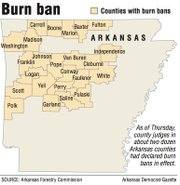For the first two months of this year, the state has seen more than double the 10-year normal average of wildfires, an Arkansas Forestry Commission spokesman said Thursday.
RELATED ARTICLE
http://www.arkansas…">Report details pilot’s actions, search efforts
Spokesman Adriane Barnes said 293 wildfires in January and 231 wildfires from Feb. 1-25 have burned more than 7,000 acres of forests and grasslands across the state.
Barnes said that despite several waves of wintry weather, humidity levels have been unusually low in the state. Low humidity is the chief environmental factor that contributes to wildfires, regardless of the season, she said.
John Robinson, the warning-coordination meteorologist for the National Weather Service in North Little Rock, said humidity in Arkansas has been as low as 15 percent several times over the past few months. The state normally gets its moisture from warm fronts from the Gulf of Mexico. This year, however, several cold fronts from the northwest have kept the warm fronts well to the state’s south.
“The [cold] fronts swept well out into the Gulf of Mexico,” Robinson said. “Since that’s where our humidity and moisture come from, we’ve gotten very little in the way of rain.”
According to the U.S. Drought Monitor, maintained by the University of Nebraska-Lincoln, the northwestern third of Arkansas is currently considered “abnormally dry.”
In January, the Little Rock area received about two-thirds of its normal rainfall amounts, Robinson said. And although the area experienced heavy rains in the first week of February, the rest of the month has been unusually dry. Robinson said Harrison, where a weather service recording station sits, received less than an inch of rain over the past month.
Barnes said that given the high number of fires so far this year, foresters with the Forestry Commission, U.S. Forest Service and other agencies are expecting more of the same in March, which is typically when forest fires increase.
“March is everybody’s favorite time of year because the temperature is up and humidity drops,” Barnes said. “More than anything else, fire activity is tied to humidity.”
Robinson said that as far as rainfall is concerned, central Arkansas is likely to receive some relief in the coming days.
“Over the weekend, we’re expecting a very wet system to come through,” Robinson said. “Starting Sunday, and into the first part of next week, we’re expecting pretty generous rainfall, getting 1 to 2 inches in central Arkansas, which should help dampen down the fire danger for a while.”
Barnes said the definition of “low humidity” is relative among the different regions throughout the nation. In Arkansas, anything below 40 percent is considered “low,” she said. Although people often assume that August is a more active month for wildfires, Barnes said, the high humidity actually keeps the fire danger low.
As of Thursday, county judges had implemented burn bans in about two dozen counties in Arkansas, covering most of the northwestern quarter of the state. The area coincides with the overall wildfire danger warning map issued by the Forestry Commission, which classified a wide band of counties stretching from the southwestern corner to the northeastern corner as being in “moderate danger” of wildfires. Twenty-two counties to the state’s northwest are in “high danger” of wildfires.
According to a commission “Wildfire Situation Report,” 69 fires Saturday burned more than 1,200 acres across the state. Nearly half of those blazes were in the commission’s 7th and 8th districts, which cover 17 counties in central and north-central Arkansas.
Barnes said humans are the leading cause of wildfires. In2013, more than 40 percent of wildfires began when landowners burned trash or dead vegetation, and more than 25 percent of all wildfires are tied to arson, according to information from the Forestry Commission.
Administrators at the Forestry Commission’s Fire Wise program, which educates people about wildfires, have been stressing a “lean, clean and green” approach to fire prevention around residences.
Sheila Doughty, the Fire Wise information officer, said homeowners who prune trees and shrubs near their homes, keep the grounds free of debris and install fire-resistant plants in yards stand the best chances of keeping their homes safe during fire season.
“What we see a lot in Arkansas is creeping fires, moving slowly through dead vegetation, until they hit ‘ladder fuels,’” said Doughty. Honeysuckle and other vines on the sides of buildings, allow flames to travel up walls onto rooftops or into the leafy canopy of trees. “Once the fire is in the trees, it takes off.”
Barnes said the Forestry Commission doesn’t record many smaller fires throughout the state. In many rural areas, smaller blazes are extinguished by the nearest volunteer fire departments, which can arrive more quickly than forestry personnel, Barnes said. Also, fires must cover at least an acre before the commission records the blaze, Barnes said.
INTERACTIVE GRAPHIC
Front Section, Pages 1 on 02/28/2014

